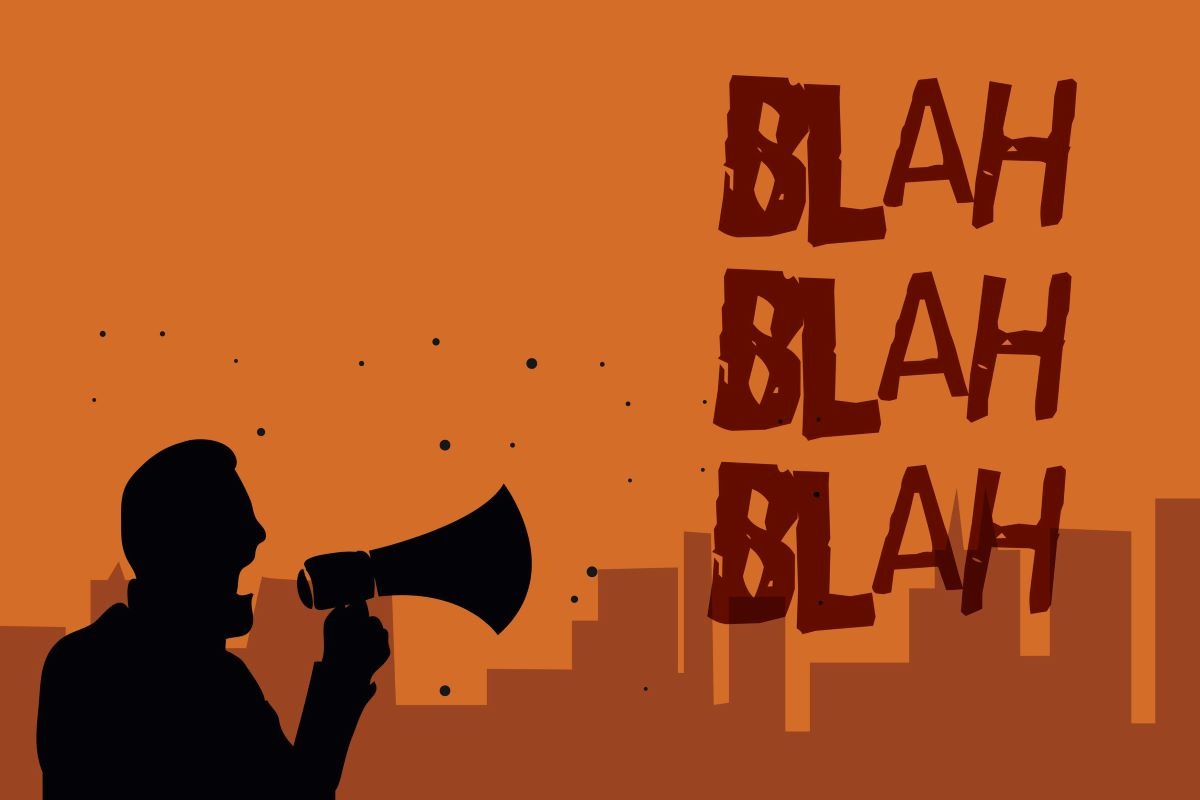5 powerful ways to beat empty rhetoric in speeches
The upcoming State of the Union will showcase best (and worst) practices for connecting and conveying confidence. Here’s what to watch for so you can achieve both.

Empty rhetoric has incredible power—to demoralize. Whether in a townhall or one-on-one with a manager, we want our leadership to convey conviction, connection and an ability to deliver on those commitments.
President Biden’s upcoming State of the Union speech is an opportunity to learn what works (and doesn’t) so you or your spokesperson can command the podium with authenticity and authority. Here’s what to watch for:
1. Emotional connection.
“President Biden’s inaugural speech was one of the best speeches I’ve seen him give over the years,” says Mike Souder, a speechwriter and former deputy communications director for the U.S. House of Representatives.
“It was well-written and projected what he wanted to,” Souder says, “in part because he’s able to make an emotional connection with the audience. That takes empathy and a willingness to be vulnerable.”
Both are evident in the president’s speeches. For example, his emotional honesty forges connections when he speaks from the heart about the loss of his first wife, daughter and his son. “It builds empathy and is authentic,” says Souder.
“You also see it in his body language,” says Patti Wood, dubbed the “Babe Ruth of body language experts” by The Washington Post. “He frequently opens his hands to the audience, which symbolizes an open heart. And he’s not afraid to cry from the podium when sharing deeply personal stories.”
Wood says the president is also good at making eye contact with the viewing audience.
“We’ll want to see that maintained in the State of the Union, because he needs to make an emotional connection with us,” she says. “He’ll need to make that connection so we feel present with him.”
2. Strength and passion.
One way to deliver a flat speech that fails to connect is to “edit the passion out,” says Noam Neusner, a former speechwriter for President George W. Bush. “You hear it when a speech starts strong and then becomes ‘a written product.’”
That’s usually the result of an overwritten and excessively edited speech.
“Speeches are meant to be heard, not read,” says Neusner. “So be careful about accepting edits where the speech becomes so fact-based and grammatical that it becomes passionless and ruins any elegance or more stylized sense.”
Wood says Americans will be comparing President Biden’s delivery with Trump’s obviously more energized, sometimes aggressive stance.
“Trump had what we call ‘broad emotional range,’ which can be incredibly appealing and captivating to audiences,” she explains. “That’s one reason he got elected and why he inspired people to do all sorts of things—good or bad.”
Wood says President Biden used to exhibit a wider emotional range in speeches and should tap back into that sense of empowerment.
“Part of the public wants him to be angry about what has happened,” she says. “Sure, you want a calm delivery that makes us feel equally calm and assured. But there’s part of us that needs to see energy, spirit and a sense of fight.”
Here’s what she’s looking for in the State of the Union, even if the president has been coached otherwise:
“I’m hoping to see more of an emotional variation than in the inaugural—including vocal characteristics of anger, higher volume and even looks of disgust and anger. We want to know he’ll step up and take care of things—and we don’t want to feel gaslit again.”
[Discover more best practices in Ragan’s March 4 “Speechwriting & Public Affairs” Virtual Conference (includes speechwriters for Former President Obama, Former First Lady Laura Bush, the U.S. House of Representatives and others, as well as public affairs pros from UPS, Walgreens, IMF, ConEdison and more.)
3. Goldilocks pacing.
“The best pace for a successful speech is about 100-120 words a minute,” says Noam Neusner, a former speechwriter for President George W. Bush. “President Bush always tried to hit 100, which is a nice sweet spot.”
When you speak too fast, you blow past people and their mind wanders,” he says. “That’s how you lose the audience.”
President Biden’s pacing is usually in the optimal range. When it dips below that threshold, it’s likely because he’s hyper-aware of his pace and phrasing as a former stutterer. The result, however, is usually a speech that includes shorter phrases, measured breaths and an equally measured pace.
4. Colloquialisms and soundbites.
President Biden used plenty of colloquialisms, personal language and everyday words in his inaugural address. It’s a particular strength of his.
“The best thing you can do as a speechwriter is emphasize and commit to your strengths—and recognize and understand your weaknesses,” says Souder. “President Biden has a stuttering problem, so he can’t have Obama-esque eloquence. Instead, he speaks in plain language and leans into it. That’s why you hear words like ‘folks’ a lot.”
In fact, Souder adds, “President Biden’s commitment to common language goes so far as his stopping people in the middle of meetings and saying, ‘Pick up the phone and tell your mom what you just said. If she understands it, we can keep talking.’”
Souder also appreciates the way the president frequently quotes his parents.
“He frames it in such a way that you feel like you’re listening to President Biden’s mom and it’s relatable,” he says. “So is his ability to pull us in when he says things like, ‘My dad would look at me at the dinner table and say, ‘Joey, it’s going to be OK.’”
5. Facts and truth.
“Another of President Biden’s strengths is that he holds the American people in such a high regard that the idea of lying to them is as unnatural as long sentences,” Souder says. “I can tell you personally that he’s a good-hearted, honest human being and through the next four years, he’ll bring us back to a place of common truth.”
What does that meant to you as a communicator? “As a profession, accuracy and truth must be the baseline for anything we’re saying,” says Souder. “That’s the floor. Start there, no matter what it takes—even if you have to lean on others.”
For example, legislative assistants (LA’s) helped Souder ensure speeches were accurate during his time on Capitol Hill.
“I learned you have to have your LA give you a brief or fact sheet before you start writing,” he says. “I’d go to the subject matter expert and ask for the facts first. Then I’d build them into my story, metaphors and soundbites—not the other way around.”
Souder says he knew plenty of speechwriters on the Hill who instead wrote the speech first, then circulated it and had others input facts.
“That’s a problem because you’re framing the narrative for the experts, instead of letting them help you frame a more factual narrative with the truth,” he says. “You don’t want to hamstring the fact-finding process.”
His advice: “If you’re a nonprofit, talk to one of your scientists or policy people first. If you don’t have subject matter experts, then build a network of experts and tap into it for the facts.”
Brian Pittman is the dean of Ragan Training and Ragan Communications’ event producer. Discover more speechwriting insights in Ragan’s March 4 “Speechwriting & Public Affairs” Virtual Conference (with speechwriters for Former President Obama, Former First Lady Laura Bush, the U.S. House of Representatives and others, as well as public affairs pros from UPS, Walgreens, IMF, ConEdison and more).






